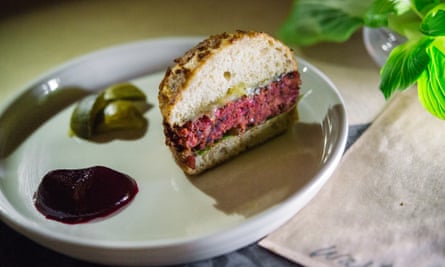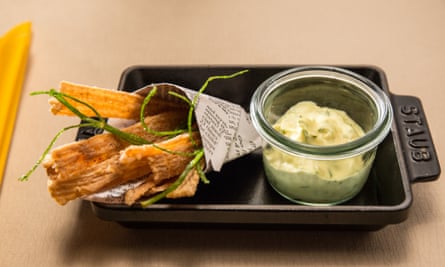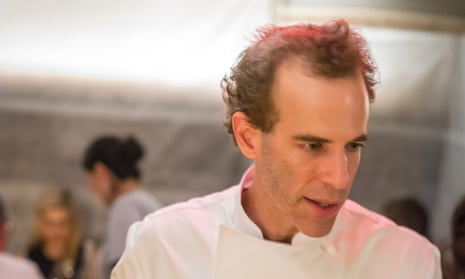Waste is central to Dan Barber’s cooking, and yet, he’d rather you didn’t sense that when you eat it. In fact, if you’re experiencing anything other than sublime thoughts when you taste his food, he’ll consider it an unsuccessful dish. Barber is the executive chef at the famed Bluehill Restaurant in Manhattan and at Stone Barns in upstate New York, and author of The Third Plate, a book about sustainable cuisine that captures his core belief: instead of just telling people to cut food waste, we should also be using it to make irresistibly tasty dishes.
To meet this goal, in March, Barber transformed his restaurant into a pop-up called wastED, where he served ‘fried skate-wing cartilage’, ‘pock-marked potatoes’ and ‘carrot top marmalade’, along with other almost-binned fare. Continuing the theme, in September, he and Sam Kass, former senior advisor for nutrition policy at the White House and now senior food analyst for NBC News, made headlines when they served ‘waste food’ to world leaders meeting at the United Nations. Barber and Kass—who first came up with the idea for the momentous lunch—created salads comprised of vegetable scraps, burgers formed from wasted beetroot juice pulp, and fries repurposed from corn intended to feed cows. The goal? To use taste to drive home the message of food waste—something that Barber says should be central to the waste debate. In conversation, he makes the case that chefs are key to accomplishing this goal—and explains why ‘waste meals’ really aren’t such a novel idea after all.
As a chef, why are you drawn to the issue of food waste?
One of the reasons I became so interested in waste food was that I wanted to expand the definition of what it means to waste. America has a wasteful food culture because of the pattern of our eating, and that kind of diet is one we’re unfortunately exporting to the rest of the world. It’s an anomaly, as I researched in my book. What I found was that in all these great cuisines of the world, the purpose of the pattern of eating that inculcated itself in the every day food culture was soaking up waste! You create dishes out of it. Food isn’t wasted; it’s bled into the culture through cooking and through cuisine.
So it’s mostly older food cultures that have this quality?
That’s one way to put it. The other way to put it is every food culture. America really is this incredible anomaly, because we’re such a young country, and when we came over here we had all these virgin soils. You’d put a seed in the ground and it became a garden of eden. We’ve never been forced into the kind of negotiation where we develop dishes that take full advantage of what the landscape can provide. In many other parts of the world the idea of a waste dinner wouldn’t be possible, or if it were possible it would be appealing to the very elite and wealthy. But for the everyday eater it was impossible: because there were so many dishes that soaked up waste, it would fail to resonate.

Are there particular examples that come to mind?
So, in Asia you might grow rice in a similar kind of fashion to the way we grow corn as a dominant crop. You’d grow buckwheat for example in Japan as a rotation crop because in order to get the rice you needed the buckwheat. In America we take the buckwheat and put it in dog food or put it back in the ground. In Japan you make soba noodles out of it. France, you have a rooster coq au vin, a tough cardboard chicken. In this country it goes into dog food or to feed fish. In France you braise it in white wine, and make a beautiful braised chicken dinner out of it. And that’s a waste product. Pot au feu is made of waste vegetables, bouillabaisse is the fish that’s damaged or bruised or unmarketable for the moment—and then you make it into this beautiful stew with saffron and it becomes an iconic French dish.
Don’t you worry that the current focus on food waste is merely a fad?
Yes I think about that a lot. Fads come and go and this is an issue that one doesn’t want to be associated with a fad because it’s just so important. That’s why I think the larger context is so critical, which is really that, if you think not leaving your plate full of food is the way to deal with this issue, you’re letting yourself off too easy. I think this is a fad that ends up disappearing if we don’t put it in the larger context: really looking at our everyday food choices, and the architecture of our plates, where you have a protein-centric plate of food—and that is an enormous waste of resources, not to mention not very delicious actually, if you look at it carefully. To me, where we need to go with this is making waste an impossibility for the future, because you’re penetrating the culture.

How do you transform a fad into something that lasts?
It’s got to happen with good dishes. That’s what it comes down to—that’s the lesson in all the cuisines of the world. Nothing lasts because you said ‘don’t waste’. At the end of the day you have to create dishes and patterns of eating that people want. The reason that so few people know that coq au vin, pot au feu and bouillabaisse are waste dishes is because they’re just so delicious—that’s the first thing that comes to mind. I think the goal here again is to create menus and dining experiences where you don’t even know you’re eating waste.
That’s why you placed so much emphasis on the UN meal being delicious?
If they’d got up and said ‘that was really interesting, we’ve got to deal more with waste,’ I would have said it wasn’t a successful meal. A successful meal is when you get up and say ‘that’s so delicious. Where can I get that burger again?’ When you’re in the political realm and you are faced with difficult choices for the future, I can imagine it’s noticeable when an idea comes along that actualises the issue. What’s powerful about cooking and eating is that you can actualise change through pleasure and taste. It sounds trite, but it’s a very powerful thing: as the great writer Michael Pollan said, we vote with our forks three times a day. That’s a lot of votes. We can transform the food system and get to a place where we need to be for the future, before the future’s going to force us to do it.

What’s the role of the chef in dealing with food waste?
The key to remember about chefs and restaurants is that we utilise waste really well. It’s in the DNA of a chef to create something delicious out of the uncoveted or the ignored, so really one place to look to solve these problems is the restaurant. I’m not suggesting that every restaurant does this perfectly, and I’m not suggesting there isn’t a lot of room for improvement. But I am saying that the ingredients are there for a movement to take hold, because you can deliver on this project through pleasure. And because in many respects, we’re already doing it. We have the power to put the pieces together in a way that very few people do, because we put these issues on the plate, literally. It’s got to be done for a context of pleasure, and actually even hedonism. That’s the lesson of history really: the efficacy for change in any realm works in mysterious ways, often very slowly if the message is one of deprivation. Actually what we’re talking about with the wastED project is hedonism and pleasure—but creating a culture around the right kind of hedonism. That’s the trick, and that’s where chefs come in because we can curate that and do it, I think, very powerfully.

Comments (…)
Sign in or create your Guardian account to join the discussion